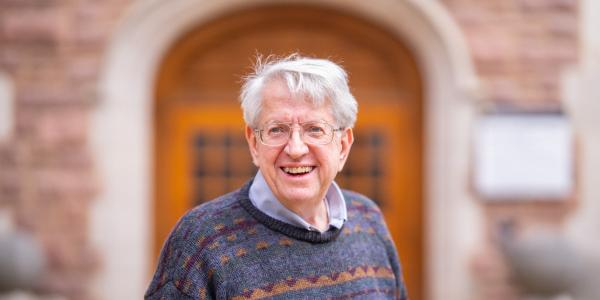Professor Bruce Fegley Retirement Lecture
50+ Years in Planetary Chemistry
My career in planetary chemistry began September 1971 when I joined the research group of John S. Lewis in my freshman year at MIT. In the 1960s Lewis pioneered computer calculations of chemical equilibria in planetary science, which we continue to do with increasingly sophisticated computer codes. The calculations can involve several thousand compounds of the 83 stable elements and are important for, e.g., predicting observable gases in the atmospheres of gas giant planets, brown dwarfs, exoplanets, and low mass dwarf stars; elemental abundances in meteoritic presolar grains, chemistry of protoplanetary disks, and chemistry of large planetary impacts.
After my B.Sc. and PhD, I moved from MIT to Harvard as a postdoc for A.G.W. Cameron, who was the second major influence on my scientific thinking. Cameron and I developed MAGMA, a code to model gas & melt chemistry during fractional vaporization of molten rock. Originally applied to the origin of the planet Mercury I later used it to model high temperature silicate volcanism on Io and chemistry of hot molten lava exoplanets (both done with staff member Laura Schaefer at WashU). At Harvard and later at MIT, I worked with Alan Kornacki on Ca, Al-rich inclusions (CAIs) in the Allende meteorite. In 1983 our work led to collaboration with Herbert Palme at the Max Planck Institute for Chemistry in Mainz, Germany. Palme and I modified his METKON code to include variable O2 pressure and rocky elements. We then modeled the large depletions in Allende CAIs of Mo and W relative to other metals with similar vapor pressures and the formation of FeO-rich olivine in Allende matrix. Kornacki and I used METKON to model volatility of refractory elements in CAIs. My time in Mainz in the 1980s led to lasting friendships and to meeting my wife, Katharina Lodders. Our marriage and collaboration is the joy of my life.
I first visited WashU in 1982 for the 45th meeting of the Meteoritical Society – hosted by the McDonnell Center for the Space Sciences – and joined the faculty in September 1991. Prior to coming here, I became interested in how long it took reactions to reach equilibrium in different environs such as protoplanetary disks, planetary atmospheres, and at the surface of Venus. I developed a simple collision theory model to estimate reaction rates in the solar nebula for formation of key minerals such as iron sulfide FeS, magnetite Fe3O4, and hydrated silicates like serpentine, which were tested later in my lab at WashU. In collaboration with Ron Prinn at MIT I had studied chemical reaction rates versus vertical mixing in the atmospheres of Jupiter and Saturn and predicted abundances of several unstable gases (AsH3, CO, GeH4, PH3) that were, however, observed in these planetary atmospheres. Following up on discrepancies between the observed and predicted abundance of SO2 in Venus’ sub-cloud atmosphere, I used my experience gained in the Ceramics Processing Research Lab with Richard Pober and H.K. Bowen to set up a gas mixing furnace and measured the rate of SO2 removal from Venus’ atmosphere by its reaction with surface minerals. This gives the volcanism rate on Venus, because the SO2 needs to be resupplied to the atmosphere to be still observable. The rate is about the same rate as subaerial volcanism on Earth. At WashU I continued experimental kinetic studies and measured the rate of pyrite decomposition on Venus’ surface in collaboration with Lodders and Göstar Klingelhöfer. Kinetic studies remained a big theme in my group: Two of my PhD students studied reaction rates: for tremolite decomposition on Venus (Natasha Johnson) and iron sulfide formation in the solar nebula (Dante Lauretta). Staff members investigated magnetite formation in the solar nebula (Yong Hong), and cuspidine formation on Venus (Bob Poli). However, chemical thermodynamics remains important to me and we continue work in this area. For his PhD, Channon Visscher modeled equilibrium chemistry and kinetics of Fe, Mg, Si, S, P in gas giant planets, brown dwarfs, and low mass dwarf stars. Rose Osborne contributed to my chemical thermodynamics book. Laura Schaefer theoretically modeled chemical equilibria during planetary outgassing, vaporization of the Earth, and on Venus. The chemistry of the Venusian atmosphere and Ionian volcanic gas chemistry always had caught my interest, and I enjoyed collaborating on this together with Misha Zolotov. New collaborations with Nate Jacobson and Gustavo Costa at NASA Glenn led to a Knudsen effusion mass spectrometric study of olivine vaporization and papers about Venus, H2O & CO2 solubility in molten carbonatites and silicates, rock solubility in steam atmospheres, and Si-O-H gas thermodynamic data. I had the luck to be able to study chemistry in many different objects in our solar system and beyond, and while all being different, the application of thermodynamics revealed many satisfying answers. It was and is my hope that students in my thermodynamics course gained an appreciation of this rigorous subject and benefit from the application of thermodynamics in their studies. -Professor Bruce Fegley
Please visit the Planetary Chemistry Laboratory Website here.
RSVP for the lecture and reception below.
RSVP
